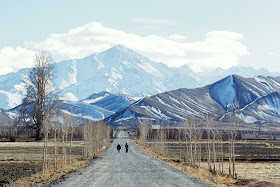In antiquity, central Afghanistan was strategically placed to thrive from the Silk Road caravans which criss-crossed the region trading between the Roman Empire, China , Central and South Asia . Bamyan was a stopping off point for many travelers. It was here where elements of Greek, Persian and Buddhist art were combined into a unique classical style, known as Greco-Buddhist art.
History;
Bamyan was the site of an early Buddhist monastery from which Bamyan takes its name from the Sanskrit varmayana ("coloured"). Many statues of Buddha are carved into the sides of cliffs facing Bamyan city. The two most prominent of these statues were standing Buddhas, now known as the Buddhas of Bamyan, measuring 55 and 37 meters high respectively, that were the largest examples of standing Buddha carvings in the world. They were probably erected in the 4th or 5th century A.D. They were cultural landmarks for many years and are listed among UNESCO's World Heritage Sites. In March 2001 the Taliban government decreed that the statues were idolatrous and ordered them to be demolished with anti-aircraft artillery and explosives.
The Buddhist remains at Bamyan were included on the 2008 World Monuments Watch List of the 100 Most Endangered Sites by the World Monuments Fund. It is hoped that the listing will put continued national and international attention on the site as a whole (including, but not limited to, the statues) in order to ensure its long-term preservation, and to make certain that future restoration efforts maintain the authenticity of the site and that proper preservation practices are followed.
Band-e Amir lakes in BamyanBamyan is also known as the capital of Daizangi and for its natural beauty. The Band-e Amir lakes in western Bamyan province continue to be a tourist destination for Afghans.
A popular route through the mountains of BamyanBamyan is currently the base of operations for the New Zealand peacekeeping force, a Provincial Reconstruction Team codenamed Task Group Crib, which is part of the network of Provincial Reconstruction Teams throughout Afghanistan
There are currently New Zealand Defence Force personnel in Bamyan. To date they have helped with reconstruction work including building bridges and schools as well as maintaining security in the region.
The New Zealand Police are also working in the region to help train the Afghan National Police (ANP). In July 2006 three Afghan women signed to join the ANP in Bamyan, the first time women have joined a police force in Afghanistan United States
District | Capital | Population |
Bamyan | Bamyan | 110,863 |
Kahmard | Kahmard | 15,643 |
Panjab | Panjab | 110,099 |
Sayghan | Sayghan | 13,001 |
Shibar | Shibar | 45,177 |
Waras | Waras | 210,787 |
Yakawlang | Nayak | 180,573 |
Capital;
Bamyan
Area;
14,175 km2 (5,473 sq mi)
Population;
387,300(2006)
Main Languages;
Dari Persian
(Hazaragi variety)
=====================================================
Bamyan Province of Afghanistan
=============================================







No comments:
Post a Comment